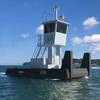Piracy: Lessons Learned
Below is the opening statement given by Chairman Elijah E. Cummings at the May 19 Coast Guard and Maritime Transportation Subcommittee hearing, “Piracy Against U.S.-Flagged Vessels: Lessons Learned.”
On February 4, 2009, I convened this Subcommittee to examine international piracy on the high seas, particularly in the Horn of Africa region.
At that time, no U.S.-flagged vessels had been attacked by pirates – and the general conclusion among our witnesses was that ships should focus on implementing the anti-piracy measures that had been identified as likely to thwart attempted pirate attacks, such as transiting the Horn of Africa at night and at the highest possible rate of speed and employing non-lethal measures such as water hoses.
Now, however, we convene in very changed circumstances. Two U.S.-flagged vessels – the Maersk Alabama and the Liberty Sun – have been attacked by Somali pirates.
One of the attacks resulted in the taking of an American Captain, Richard Phillips, hostage. He was freed only through the decisive intervention of U.S. military forces, including Navy SEALs, who eventually killed the pirates holding Captain Phillips after it became clear his life was in imminent danger.
These attacks against the Maersk Alabama and the Liberty Sun are the first known pirate attacks against a U.S.-flagged vessel since the end of our war with the Barbary pirates in the early 1800s.
These attacks – conducted by young men from the desperately poor nation of Somalia who have few legitimate opportunities to earn a living and who arm themselves with RPGs and AK-47s and take to the seas in small boats – represent in many ways the asymmetry of the threats that we as a nation confront today.
That said, the U.S.-flagged merchant fleet has always been able to rely on the protection of the U.S. Navy to ensure its safety. As we saw with the Maersk Alabama, that Navy is more than capable of handling this current threat.
Nonetheless, at the present time, it appears that the U.S.-flagged fleet is essentially being left to handle its immediate security needs by itself.
On May 12, the Coast Guard issued Maritime Security Directive 104-6, which purports to “provide[…] the maritime industry with specific, risk-based measures to take to deter, detect or disrupt piracy.”
Specifically, the Directive requires U.S.-flagged vessels to adopt an anti-piracy plan before entering high risk waters and to employ those measures known to help prevent pirate attacks, including transiting through established transit lanes, utilizing erratic course changes, and traveling at the highest possible speeds.
Additionally, the Directive requires vessels to “supplement ship’s crew with armed or unarmed security based on a piracy specific vessel threat assessment conducted by the operator and approved by the Coast Guard.”
While these are sensible recommendations that a merchant vessel should follow to protect itself while transiting waters where pirate attacks are common, there is a broader question to be considered.
Why is it that the best our nation appears to have to offer our merchant mariners at this time is instructions on the steps they should take to protect themselves?
It is not at all clear to me why the Navy or, in the absence of a willingness to act on the part of the Navy, the Coast Guard, isn’t providing embarked military personnel on the few U.S.-flagged vessels that transit the Horn of Africa region – most of which, I note, are carrying U.S.-government impelled cargoes.
While I have no doubt that the Navy would respond immediately if another attack occurs against a U.S.-flagged vessel – the timeliness of their response could be hindered if Navy assets are far from the scene of the attack.
And sadly, in the time that it takes the Navy to respond to an incident, another hostage situation may have been created – putting another U.S. mariner at the mercy of pirates who have already announced their intention to take revenge against U.S. mariners for the deaths of their pirate colleagues in the Maersk Alabama incident.
Given these realities, I don’t believe the Department of Defense would really argue that U.S.-flagged vessels are safer if they are left to protect themselves.
Nor do I think the DOD would argue that it is preferable to respond to an incident rather than to prevent an incident from occurring.
That said, the issue we must explore is the following. We have long argued that we need a U.S.-flagged merchant fleet to carry U.S.-government cargoes and to provide sealift capacity to support DOD needs in time of war and national emergency.
For that reason, we have created the Maritime Security Program, which provides direct payments to U.S.-flagged ships to ensure that they are available when the government needs them.
Given this, isn’t it in our national interest to utilize the very limited U.S. military resources that would be necessary to protect our U.S.-flagged fleet rather than leaving them to implement their own defensive measures?












